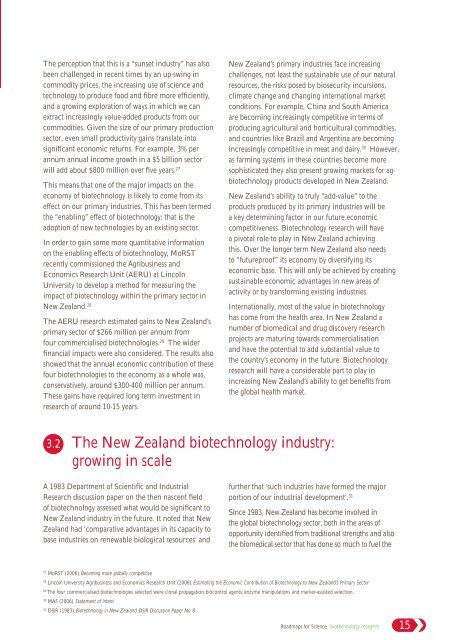Biotechnology Research Roadmap - Science and Innovation
Biotechnology Research Roadmap - Science and Innovation
Biotechnology Research Roadmap - Science and Innovation
You also want an ePaper? Increase the reach of your titles
YUMPU automatically turns print PDFs into web optimized ePapers that Google loves.
The perception that this is a “sunset industry” has also<br />
been challenged in recent times by an up-swing in<br />
commodity prices, the increasing use of science <strong>and</strong><br />
technology to produce food <strong>and</strong> fibre more efficiently,<br />
<strong>and</strong> a growing exploration of ways in which we can<br />
extract increasingly value-added products from our<br />
commodities. Given the size of our primary production<br />
sector, even small productivity gains translate into<br />
significant economic returns. For example, 3% per<br />
annum annual income growth in a $5 billion sector<br />
will add about $800 million over five years. 27<br />
This means that one of the major impacts on the<br />
economy of biotechnology is likely to come from its<br />
effect on our primary industries. This has been termed<br />
the “enabling” effect of biotechnology; that is the<br />
adoption of new technologies by an existing sector.<br />
In order to gain some more quantitative information<br />
on the enabling effects of biotechnology, MoRST<br />
recently commissioned the Agribusiness <strong>and</strong><br />
Economics <strong>Research</strong> Unit (AERU) at Lincoln<br />
University to develop a method for measuring the<br />
impact of biotechnology within the primary sector in<br />
New Zeal<strong>and</strong>. 28<br />
The AERU research estimated gains to New Zeal<strong>and</strong>’s<br />
primary sector of $266 million per annum from<br />
four commercialised biotechnologies. 29 The wider<br />
financial impacts were also considered. The results also<br />
showed that the annual economic contribution of these<br />
four biotechnologies to the economy as a whole was,<br />
conservatively, around $300-400 million per annum.<br />
These gains have required long term investment in<br />
research of around 10-15 years.<br />
New Zeal<strong>and</strong>’s primary industries face increasing<br />
challenges, not least the sustainable use of our natural<br />
resources, the risks posed by biosecurity incursions,<br />
climate change <strong>and</strong> changing international market<br />
conditions. For example, China <strong>and</strong> South America<br />
are becoming increasingly competitive in terms of<br />
producing agricultural <strong>and</strong> horticultural commodities,<br />
<strong>and</strong> countries like Brazil <strong>and</strong> Argentina are becoming<br />
increasingly competitive in meat <strong>and</strong> dairy. 30 However,<br />
as farming systems in these countries become more<br />
sophisticated they also present growing markets for agbiotechnology<br />
products developed in New Zeal<strong>and</strong>.<br />
New Zeal<strong>and</strong>’s ability to truly “add-value” to the<br />
products produced by its primary industries will be<br />
a key determining factor in our future economic<br />
competitiveness. <strong>Biotechnology</strong> research will have<br />
a pivotal role to play in New Zeal<strong>and</strong> achieving<br />
this. Over the longer term New Zeal<strong>and</strong> also needs<br />
to “futureproof” its economy by diversifying its<br />
economic base. This will only be achieved by creating<br />
sustainable economic advantages in new areas of<br />
activity or by transforming existing industries.<br />
Internationally, most of the value in biotechnology<br />
has come from the health area. In New Zeal<strong>and</strong> a<br />
number of biomedical <strong>and</strong> drug discovery research<br />
projects are maturing towards commercialisation<br />
<strong>and</strong> have the potential to add substantial value to<br />
the country’s economy in the future. <strong>Biotechnology</strong><br />
research will have a considerable part to play in<br />
increasing New Zeal<strong>and</strong>’s ability to get benefits from<br />
the global health market.<br />
3.2 The New Zeal<strong>and</strong> biotechnology industry:<br />
growing in scale<br />
A 1983 Department of Scientific <strong>and</strong> Industrial<br />
<strong>Research</strong> discussion paper on the then nascent field<br />
of biotechnology assessed what would be significant to<br />
New Zeal<strong>and</strong> industry in the future. It noted that New<br />
Zeal<strong>and</strong> had ‘comparative advantages in its capacity to<br />
base industries on renewable biological resources’ <strong>and</strong><br />
further that ‘such industries have formed the major<br />
portion of our industrial development’. 31<br />
Since 1983, New Zeal<strong>and</strong> has become involved in<br />
the global biotechnology sector, both in the areas of<br />
opportunity identified from traditional strengths <strong>and</strong> also<br />
the biomedical sector that has done so much to fuel the<br />
27<br />
MoRST (2006), Becoming more globally competitive<br />
28<br />
Lincoln University Agribusiness <strong>and</strong> Economics <strong>Research</strong> Unit (2006), Estimating the Economic Contribution of <strong>Biotechnology</strong> to New Zeal<strong>and</strong>’s Primary Sector<br />
29<br />
The four commercialised biotechnologies selected were clonal propagation; biocontrol agents; enzyme manipulations <strong>and</strong> marker-assisted selection.<br />
30<br />
MAF (2006), Statement of Intent<br />
31<br />
DSIR (1983), <strong>Biotechnology</strong> in New Zeal<strong>and</strong>, DSIR Discussion Paper No. 8.<br />
<strong>Roadmap</strong>s for <strong>Science</strong> : biotechnology research<br />
15












![[Tam] Uygula[ya] - Bilim, Teknoloji ve Ä°novasyon Politikaları TartıÅma ...](https://img.yumpu.com/36820041/1/184x260/tam-uygulaya-bilim-teknoloji-ve-anovasyon-politikalara-tartaama-.jpg?quality=85)



